Keanu Reeves' Motorcycle Is an Extremely Exotic, Entirely Excessive Machine
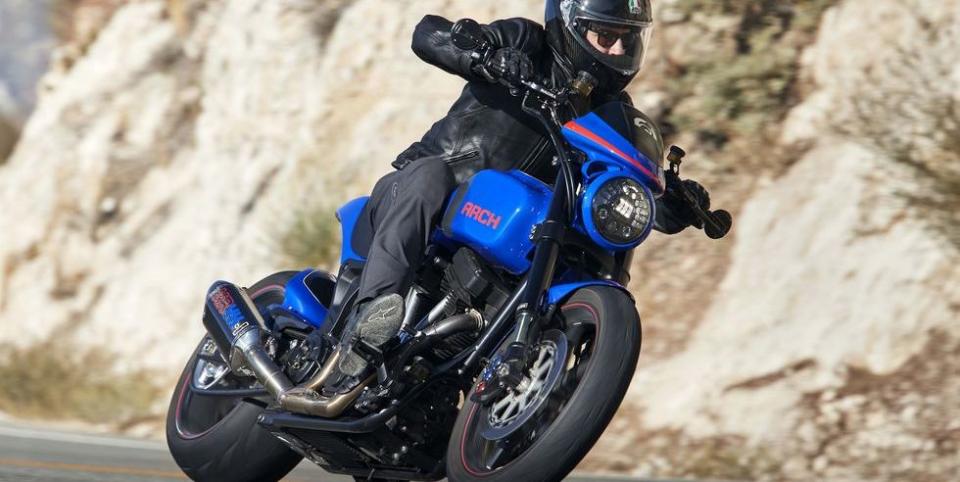
Hawthorne, California, feels like a vision of the state’s golden age. Things are built here. Rockets jut through yawning hangar doors. Jet assemblies churn from anonymous, slab-sided industrial centers. A steady stream of trucks grind through town, belching diesel exhaust into the sepia daylight, adding their clatter to the dull roar of highways and airport traffic. On a busy street lined with freight operators and check-cashing shops, those trucks deposit big blocks of 6061 aluminum, dull and new, into another low building. There, those blocks are ground and shaped by monster CNC machines, reducing around 950 pounds of billet aluminum into three giant bins of curled filings. What’s left rolls out the door as one of the most exotic motorcycles ever made: the Arch KRGT-1.
This story originally appeared in the February 2020 issue of Road & Track.
The Arch began as the brainchild of actor Keanu Reeves, the bike he wanted to ride but couldn’t find: a purposeful, powerful, and distinctively American cruiser. So he cajoled fabricator Gard Hollinger into building the thing.
Reeves liked the result. He liked Hollinger, too, and convinced him to partner up and form a company building the low-slung KRGT-1 from scratch, serializing the design under the Arch name. Dozens of delivered motorcycles later, the fledgling company doesn’t look so fledgling. Its motorcycles pass stringent emissions tests. Its partnerships with electronics manufacturers and suppliers have led to razor-slim tolerances between carbon and aluminum parts, and wiring looms elegant in both efficiency and packaging.
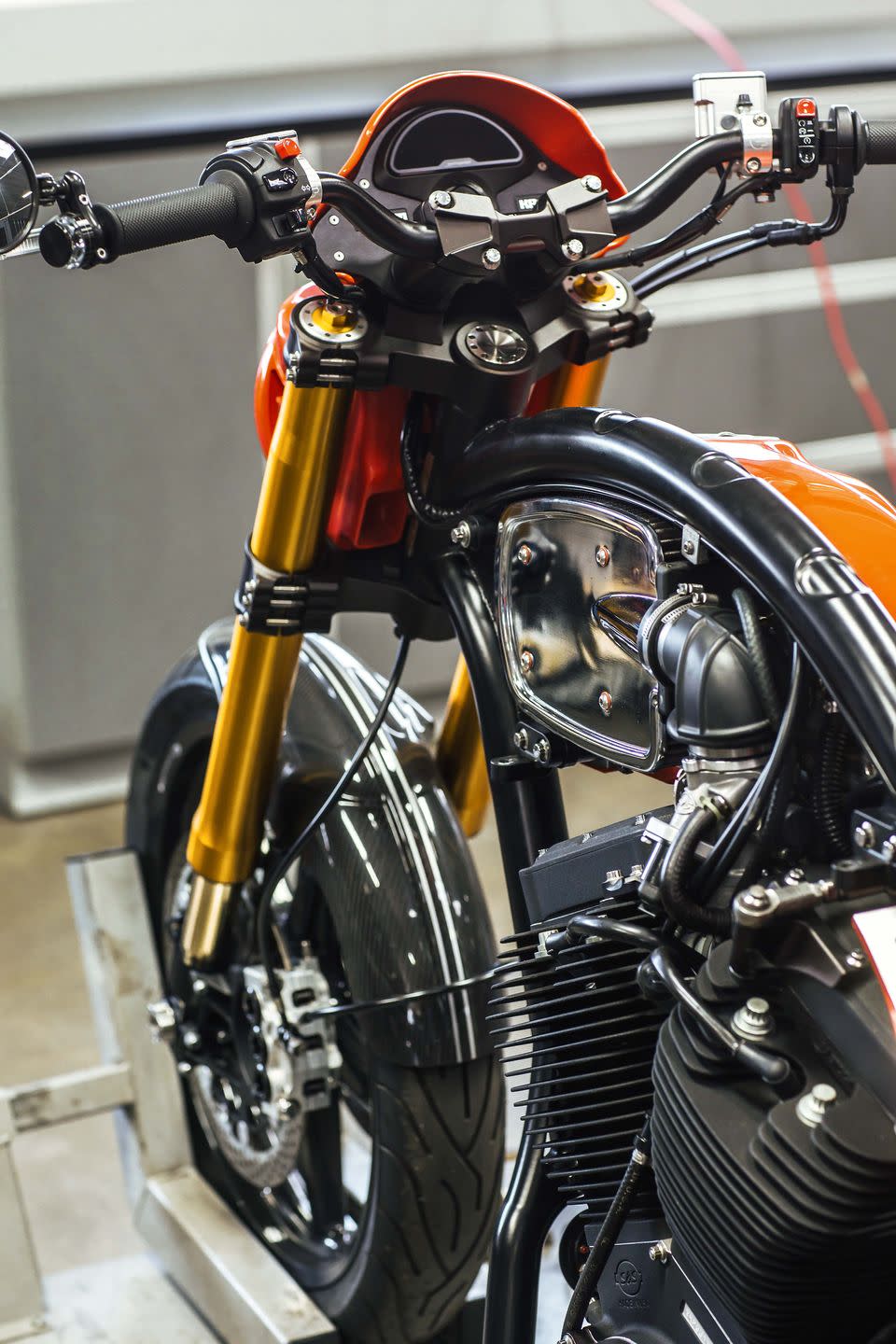
There is, in the KRGT-1, a recipe for an evil-handling machine. The bike has a monster 240-millimeter rear tire, forward foot controls, and a claimed dry weight of 538 pounds. All that mass is spread over a 66-inch wheelbase. Power is provided by a beautiful, S&S-built V-twin that seems perfectly to scale—until a little math converts its 124 cubic inches of displacement into a jaw-dropping 2.0 liters.
Excess on a motorcycle is rarely endearing. More than a few forward-control, big-bore motorcycles handle like peg-dragging, howitzer-powered gynecological exam tables. It takes engineering and attention to detail to make a great, big thing like the KRGT-1 work.
Top-shelf parts don’t hurt. Carbon wheels from South African firm Blackstone Tek help minimize unsprung weight, huge brakes put speed in check with incredible efficiency, and adjustable Öhlins suspension keeps the rangy machine under control. With each jug displacing superbike volume, fueling has to be spot-on to keep the KRGT-1 from menacing its rider, and there, Arch has succeeded. The engine is as smooth and steady as two dinner-plate-sized pistons can manage. Those forward controls still separate you from the bike, sending you into tricky corners feet-first and a little helpless if you want to smoothly shift your weight. But they redeem themselves with clearance, staying out of the way even when you lean the bike low. A sculpted seat locks you into a relaxed, country-crossing posture.
Climbing up out of Pasadena, the amber brake fluid in the master cylinder reservoir vibrates atop the bars in concentric circles. As the engine picks up speed, those little rings disappear, then blur into a violent squall. It’s mesmerizing in the way a lava lamp can be, but lava lamps aren’t mounted to the handlebar of an $85,000 motorcycle, or hurtling with you up Angeles Crest Highway, Keanu Reeves hot on your heels.
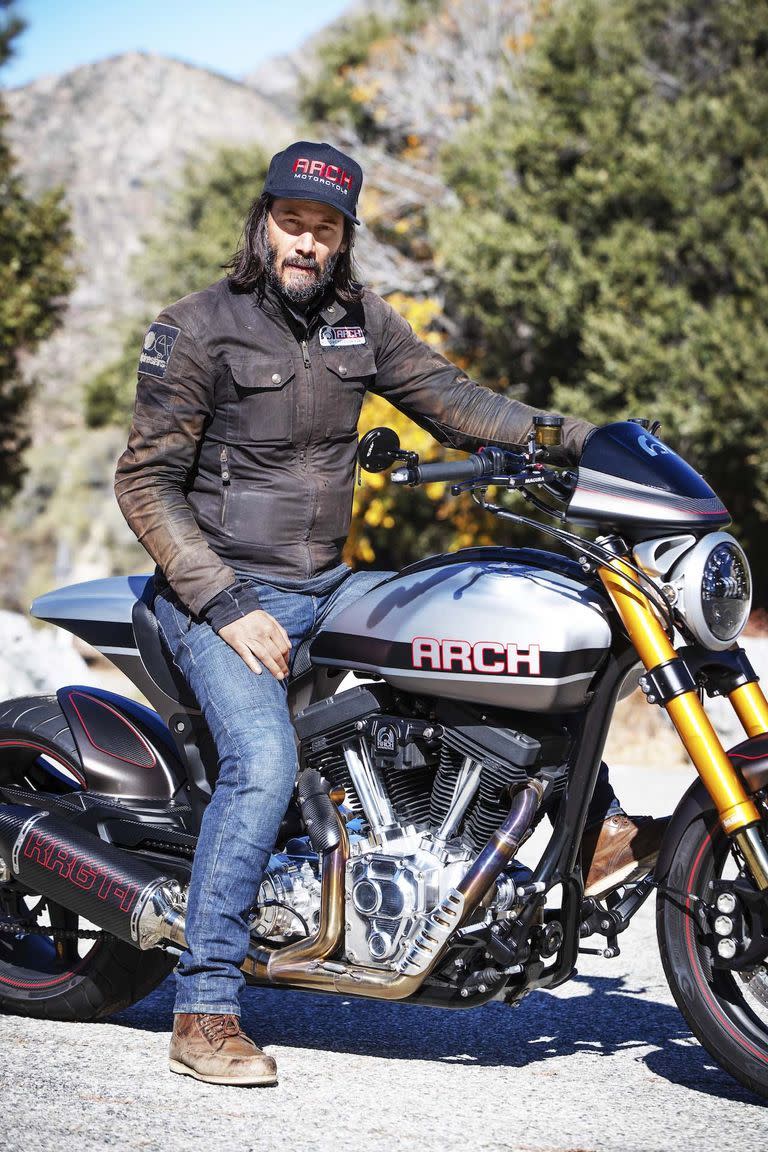
Asked if he has an ideal riding day on the motorcycle, Reeves names the road we’re on, then expands his horizons to the Santa Monica Mountains. Then he thinks a little more and lists, for good measure, more spectacular roads, a trip to the nearby town of Ojai, and a ride to Las Vegas. He’s not wrong.
Every corner exit is an opportunity to feel that big engine stretch from the bottom of its range. And when the road bends back on itself, it’s an excuse to unwind the throttle and let the exhaust pop a muted Lionel Hampton drum solo at your ankles. The KRGT-1 rewards that kind of relaxed riding. When you push, it complies, transitioning surprisingly quickly, but it also raises an eyebrow. Even mid-corner, the machine requires engagement, a bit of supervision on the bars.
We take a break in the shade of pine trees, and Reeves traces the fat welds joining pieces of the aluminum tank. They’re almost perfect—two rows of overlapping dimes stretched along the bike’s steel backbone.
“This weld is no joke,” he says quietly. “We have one guy who does it. He’s our guru. Our weld guru. It’s a beautiful weld. There’s some fire in it.”
As he obsesses, his hands lever out the seat. He points to the tidy wiring, the integrated battery maintenance port.
“But look at that,” he says. “It’s like art.”
“He understands all the work it takes,” Hollinger says of Reeves, amused. “But that doesn’t stop him saying, ‘C’mon, let’s go. Let’s do it. More!’”
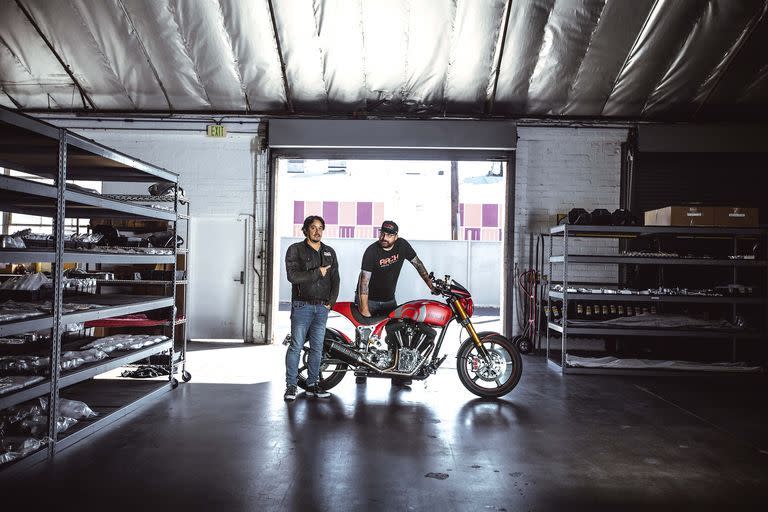
More, in this case, means evolution and refinement. Stand 10 feet from an early production bike and the current KRGT-1 and the differences are hard to spot. Get close and they pop. There are 150 or so changes, 20 large enough for Hollinger to call out. The new swing arm is the most noticeable. It’s gone from a pretty, lithe thing seemingly plucked from a sportbike to a massive billet piece. The new design dominates the rear end, adding an aesthetic gravity that the bike needed. It also shaves five pounds.
Ryan Boyd builds those swing arms back in Hawthorne. Aluminum shavings fall from his beard when he speaks. His voice is barely audible over the sound of CNC machines carving KRGT-1 parts from raw metal. He shows us how different cutting techniques can drastically change the metal’s appearance, demonstrating how the tiniest edge of a massive bit can carve delicate lines into soft aluminum.
The cutting tool Boyd holds can make thousands of parts before it expires. It can do profile milling or take off large amounts of material in a radial step. Or it can be used at an angle, to clean up a corner. In Boyd’s computer-assisted hands, that tool is used to cut intricate, beautiful surfaces into the big swing arm. It’s a question of step-over, of the direction the tool is cutting. One direction might leave aluminum in front of the tool, feeding material to a hot bit and welding it back into the cut.
“It’s a balance between how quickly you can remove the material and make an art form out of it,” Boyd says.
He pulls a side of a swing arm, still coated in cutting coolant, from one of the mills. The piece took two months to design, and each example will take 18 hours of millwork to finish. Their fillets won’t make the KRGT-1 faster, or lighter, or stronger. Some customers will choose to have those additions polished away or anodized, missing how the subtle curves echo and accentuate the bike’s shape. That couldn’t bother Boyd less.
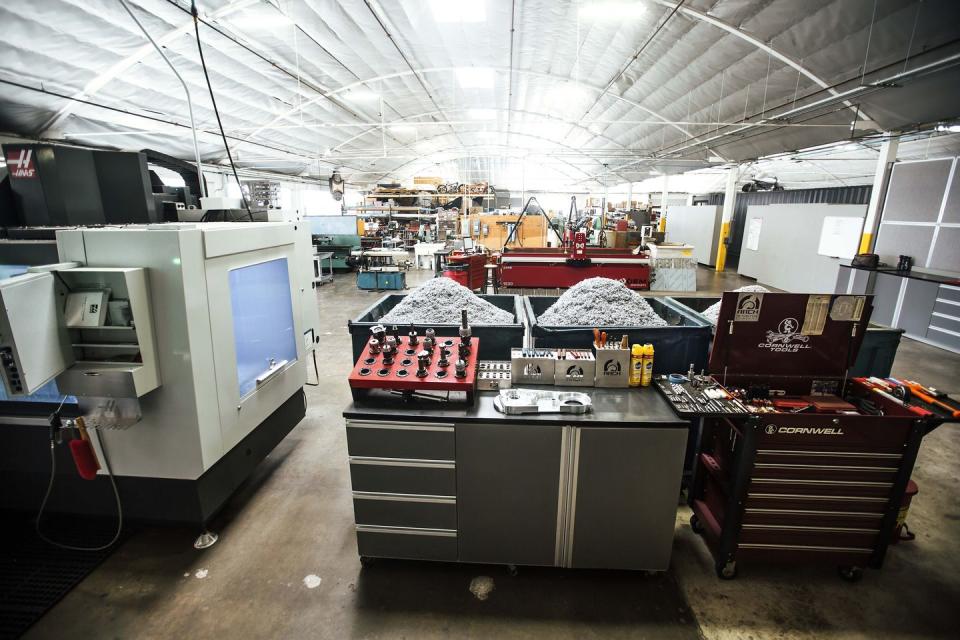
“We want to give customers the opportunity to have that part,” he says. “It should stand on its own, without paint or anodizing.”
But while customers can have their swing arm any way they like, this side of the machine is truly special. The contrast of a heavy-hitting engine and big cruiser wheelbase with intricate detail. The detail separates the bike from more common customs, or performance-
focused factory machines, any of which can be had for tens of thousands of dollars less.
“Most people don’t ever meet me,” Boyd continues, watching a carbide bit dig into material. The metal moans like a ship’s whistle, throwing a cascade of aluminum into the side of the machine’s enclosure like hail on a windshield. He waits for the noise to abate. “I want them to look at that part and say, Holy cow, Arch made that. And that’s as good as shaking their hand and saying, ‘Hey, I’m Ryan,’ right?”
Dozens of options make the KRGT-1 bespoke. Perfect paint. A choice of upholstery and controls set up for maximized comfort. A number of anodizing and metal-treatment options. Maybe the most tailored thing on it is imperfection, proof of the hands that put it together. The dash is bright and functional, but more visually suited to a shifter kart than an exotic motorcycle. The signal controls are easy to navigate, but they’re plastic pieces amid an orgy of handmade fixtures.
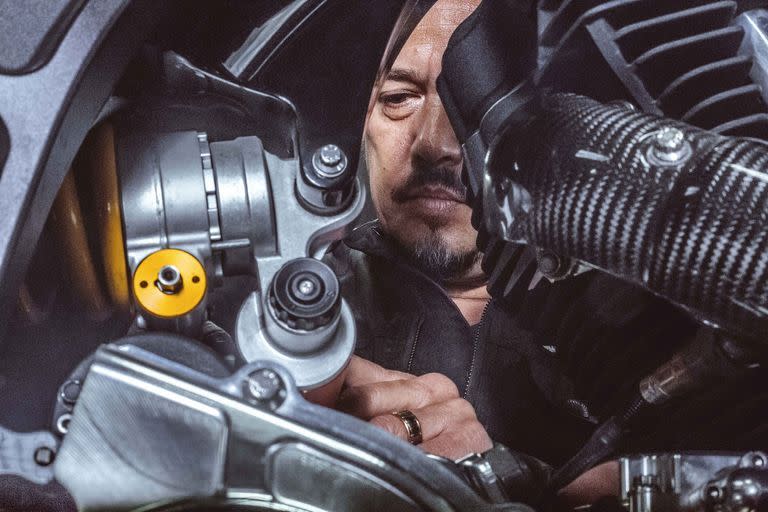
It all points to a living machine, each model—each new serial number—a separate mutation. Arch’s shop is small by manufacturing standards. Everyone takes on different jobs, everyone rides, everyone refines. A new sprocket can be cut on the fly on the waterjet table, tried, adopted, or rejected. The best ideas are built into the next motorcycle out the door. Reeves has put tens of thousands of miles on the machines, and he liked the long legs of Boyd’s new cog. The way the bike carried 80 mph in sixth at a lazy 2800 rpm. Order a KRGT-1 today and it has the same evolved sprocket.
Every bike out the door becomes a snapshot of what works best, and a reflection of its owner’s wants. That means the KRGT-1 isn’t for everyone. It’s not for a perfectionist, or for riders searching for the peak of performance, or for anyone on any kind of reasonable budget. It’s also not for the impatient—each example takes 90 days to build. But it is undeniably special, rare, and handmade. A kinetic window into the minds of a few dedicated and talented people. And it’s only getting better.
You Might Also Like

 Yahoo Autos
Yahoo Autos 